
Leptospermum is a genus of shrubs and small trees in the myrtle family Myrtaceae commonly known as tea trees, although this name is sometimes also used for some species of Melaleuca. Most species are endemic to Australia, with the greatest diversity in the south of the continent but some are native to other parts of the world, including New Zealand and Southeast Asia. Leptospermums all have five conspicuous petals and five groups of stamens which alternate with the petals. There is a single style in the centre of the flower and the fruit is a woody capsule. The first formal description of a leptospermum was published in 1776 by the German botanists Johann Reinhold Forster and his son Johann Georg Adam Forster, but an unambiguous definition of individual species in the genus was not achieved until 1979. Leptospermums grow in a wide range of habitats but are most commonly found in moist, low-nutrient soils. They have important uses in horticulture, in the production of honey and in floristry.
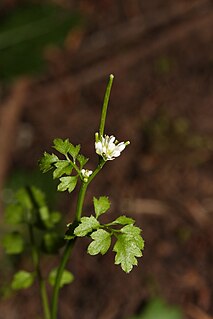
Cardamine is a large genus of flowering plants in the mustard family, Brassicaceae, known as bittercresses and toothworts. It contains more than 200 species of annuals and perennials. Species in this genus can be found worldwide, except the Antarctic, in diverse habitats. The name Cardamine is derived from the Greek kardamon, cardamom, an unrelated plant in the ginger family, used as a pungent spice in cooking.
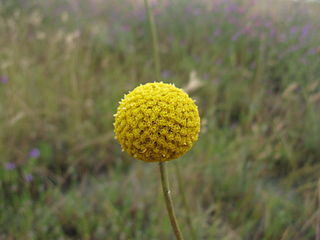
Pycnosorus is a genus of six species of plants in the daisy family Asteraceae. Commonly known as billy buttons or drumsticks, they are annual or perennial herbs or small shrubs with a cylindrical to spherical head of up to 200 daisy-like "flowers". Each "flower" is a pseudanthium consisting of between three and eight florets surrounded by bracts. The petals are joined to form a small tube and the florets with their surrounding bracts are yellow or golden-yellow.

Xerochrysum bracteatum, commonly known as the golden everlasting or strawflower, is a flowering plant in the family Asteraceae native to Australia. Described by Étienne Pierre Ventenat in 1803, it was known as Helichrysum bracteatum for many years before being transferred to a new genus Xerochrysum in 1990. It grows as a woody or herbaceous perennial or annual shrub up to a metre (3 ft) tall with green or grey leafy foliage. Golden yellow or white flower heads are produced from spring to autumn; their distinctive feature is the papery bracts that resemble petals. The species is widespread, growing in a variety of habitats across the country, from rainforest margins to deserts and subalpine areas. The golden everlasting serves as food for various larvae of lepidopterans, and adult butterflies, hoverflies, native bees, small beetles, and grasshoppers visit the flower heads.
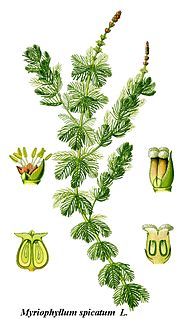
Haloragaceae is a eudicot flowering plant family in the order Saxifragales, based on the phylogenetic APG system. In the Cronquist system, it was included in the order Haloragales.

Philotheca is a genus of about fifty species of flowering plant in the family Rutaceae. Plants in this genus are shrubs with simple leaves arranged alternately along the stems, with flowers that usually have five sepals, five petals and ten stamens that curve inwards over the ovary. All species are endemic to Australia and there are species in every state, but not the Northern Territory.

Hovea is a genus of perennial shrubs which are native to Australia. Species from this genus are occasionally cultivated as ornamental plants. The genus name honours Anton Pantaleon Hove, a Polish plant collector.
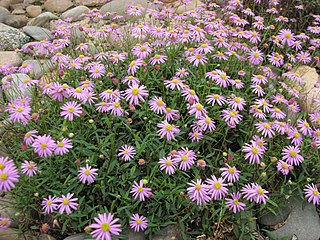
Brachyscome is a genus of flowering plants in the aster family, Asteraceae. Most are endemic to Australia, and a few occur in New Zealand and New Guinea.

Brachyglottis is a genus of flowering plants in the aster family, Asteraceae. The genus was erected on November 29, 1775, by Johann Reinhold Forster and Georg Forster. The name was derived from the Greek brachus ("short") and glottis a reference to the size of the ray florets.

Helichrysum luteoalbum is commonly known as Jersey cudweed or cat's paw.

Olearia phlogopappa commonly known as the dusty daisy-bush or alpine daisy-bush is a species of flowering plant in the family Asteraceae that is commonly found in eastern New South Wales, Victoria and Tasmania. It is a small shrub with greyish-green foliage, daisy-like flowers in white, pink or mauve that can be seen from spring to late summer.

Dichondra repens is a small, prostrate, herbaceous plant native to New Zealand and many parts of Australia. It is occasionally known as kidney weed in Australia and as Mercury Bay weed in New Zealand. Most commonly called dichondra in Australia.

Euchiton is a genus of flowering plants in the daisy family. They are native to Australasia and the Pacific. Some have been introduced far outside their native ranges.

Coronidium scorpioides, commonly known as the button everlasting, is a perennial herbaceous shrub in the family Asteraceae found in Australia. Previously known as Helichrysum scorpioides, it was placed in the newly described genus Coronidium in 2008.
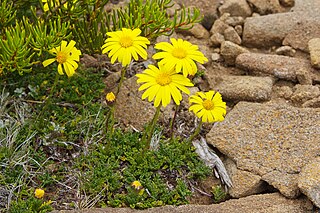
Senecio pectinatus, commonly known as alpine groundsel, is a species of flowering plant in the aster family. The species occurs in alpine areas of south-eastern Australia in peat-based soils. It has divided leaves forming a basal rosette and produces a single yellow flower head on a stalk up to 20 cm high.

Ozothamnus alpinus, commonly known as alpine everlasting, is a shrub in the family Asteraceae. It is native to alpine and subalpine areas in the states of New South Wales and Victoria in Australia.

Craspedia variabilis, commonly known as billy buttons is an erect annual or perennial herb which occurs in all mainland states of Australia except for the Northern Territory and in a wide range of habitats in temperate zones but not in alpine areas.
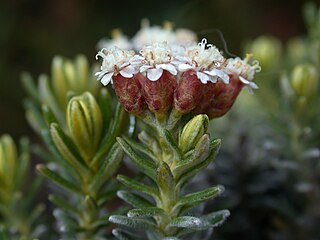
Ozothamnus ledifolius is a shrub, from the family Asteraceae and one of 54 species from the genus Ozothamnus. Harold Frederick Comber (1897–1969), an English horticulturist and plant collector, introduced Ozothamnus ledifolius in 1929 on mountains of Tasmania above 2500 ft. high from the seeds collected from 4000 ft. height.
Paul Irwin Forster obtained his doctorate in 2004 with his thesis: The pursuit of plants : studies on the systematics, ecology and chemistry of the vascular flora of Australia and related regions, from the University of Queensland.
Joy Thompson was an Australian botanist. Her main research areas were taxonomy and Myrtaceae.



















